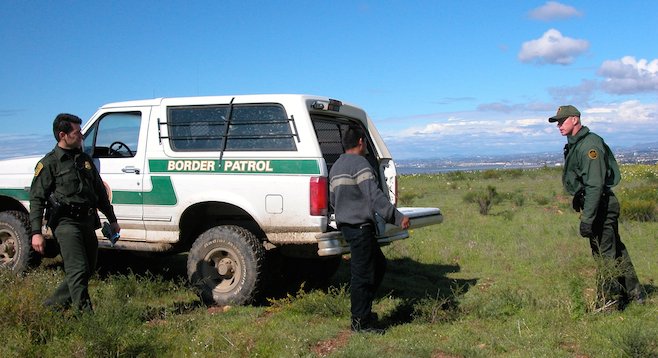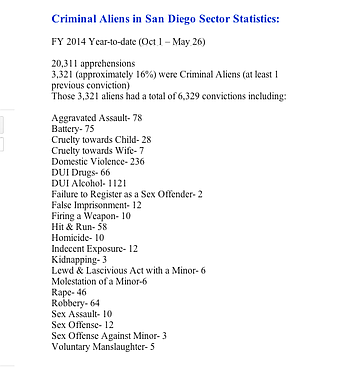 Facebook
Facebook
 X
X
 Instagram
Instagram
 TikTok
TikTok
 Youtube
Youtube

Of the more than 20,000 people apprehended by the U.S. Border Patrol in San Diego in the first eight months of this fiscal year, 3321 of them had a total of 6329 criminal convictions for crimes against people or driving under the influence. That's according to San Diego sector spokesman Paul Carr, who sorted through the agency's current numbers at the request of this reporter.

Those numbers do not include minor crimes such as petty theft, vandalism, disorderly conduct, graffiti, and things that are generally charged as misdemeanors; auto theft, drug-smuggling, and drug-use convictions are not included either. Nor are outstanding arrest warrants or federal charges for repeatedly crossing the border illegally. And the routine checks of the National Criminal Intelligence Center do not turn up information about criminal charges and convictions in other countries.
Border Angels founder and migrant activist Enrique Morones points out that the majority of the people apprehended in this sector do not have criminal convictions.
"This tells us that most migrants are not criminals. They are deporting housekeepers, gardeners, and children," he says. "It's very sad and shameful."
Former U.S. Attorney Peter Nuñez points out that by virtue of crossing the border illegally, a crime was committed — one not counted in these statistics.
A report by the U.S. Government Accountability Office in December 2012 noted that the San Diego sector had the second-highest rate and numbers of repeated illegal border-crossers, at around 52 percent. El Centro had the highest repeater rate, but Tucson had the highest number of repeaters. Those numbers don't show up in the NCIC conviction statistics because prosecutions are generally deferred until the person is caught a second time.
Among the 3321 people with convictions for crimes against people and DUIs captured by Border Patrol agents between October 1, 2013, and May 26, 2014, there were 10 homicide convictions, 5 voluntary manslaughter convictions, 78 aggravated assault, and 75 battery convictions.
Sexual violence convictions include 46 rape convictions, 10 sexual assault convictions, and 15 convictions for sex offenses involving minors. There were also 12 convictions for indecent exposure, 12 convictions for unspecified sexual offenses, and 2 convictions for failure to register as sex offenders. There were 1187 convictions for driving under the influence of drugs and alcohol and 58 hit-and-run convictions. Domestic violence convictions numbered 236, and an additional 35 convictions were for cruelty to a wife or child.
Border Patrol agents making the apprehensions say that sometimes it’s easy to spot the convicts. While tattoos are common, one agent says, “You can tell if they’re cheap homemade from the village they came from or a cheap Walkman-motor tattoo from prison or an expensive tattoo from a weekend in Vegas.”
Agents say that extreme deference from a detainee is often a tip-off that they’ve been in the prison system, as is a good grasp of English when it comes to the language of arrest.
“There are guys who are very polite to you and they say, ‘Yes, sir; no, sir,’ and even though they’re crawling in the dirt they keep themselves clean — that’s from being institutionalized,” another agent says.
Patrol agents working alone often catch groups of people running the border together, and even if one person stands out as a convicted criminal, the agents are watchful of the whole group.
“We watch them all,” an agent says. “You don’t know who you have or how dangerous they are until you process them, so our training is you watch them all.”
Former federal prosecutor Nuñez says that the numbers don’t surprise him.
“The real question about the 3321 is what happened to them after they were caught,” Nuñez says. “The Border Patrol arrests and turns them over to [Immigration and Customs Enforcement], and what should happen is ICE investigates their backgrounds and one of three things follow: they are sent for prosecution to the U.S. Attorney’s office; they are set up for deportation; or they are granted voluntary departure (the alien waives his right to a deportation hearing and is deported). But what has been happening is that the Obama administration has ordered many of them released from custody into the community.”
Asked what happened to the criminals, ICE spokeswoman Virginia Kice says that the criminal aliens’ fates were decided on a case-by-case basis.
“Serious crimes are always a basis for removal. Crimes where the sentence was a year or more may be a basis for deportation. We look at their ties to the community, at their immigration history, and their conviction record. There’s no one-size-fits-all answer.”
But each case still has to go to an immigration judge. And that’s a frustration for ICE.
“We see DUI as a threat to public safety,” Kice says. “Removal for DUIs has been extensively litigated and the person may be allowed to remain in the U.S.”
The immigration courts don’t always side with ICE, she says.
“We can put a person into removal proceedings and the courts can still decide to let someone stay — if they will be tortured if we return them to their own country, for example.”


Of the more than 20,000 people apprehended by the U.S. Border Patrol in San Diego in the first eight months of this fiscal year, 3321 of them had a total of 6329 criminal convictions for crimes against people or driving under the influence. That's according to San Diego sector spokesman Paul Carr, who sorted through the agency's current numbers at the request of this reporter.

Those numbers do not include minor crimes such as petty theft, vandalism, disorderly conduct, graffiti, and things that are generally charged as misdemeanors; auto theft, drug-smuggling, and drug-use convictions are not included either. Nor are outstanding arrest warrants or federal charges for repeatedly crossing the border illegally. And the routine checks of the National Criminal Intelligence Center do not turn up information about criminal charges and convictions in other countries.
Border Angels founder and migrant activist Enrique Morones points out that the majority of the people apprehended in this sector do not have criminal convictions.
"This tells us that most migrants are not criminals. They are deporting housekeepers, gardeners, and children," he says. "It's very sad and shameful."
Former U.S. Attorney Peter Nuñez points out that by virtue of crossing the border illegally, a crime was committed — one not counted in these statistics.
A report by the U.S. Government Accountability Office in December 2012 noted that the San Diego sector had the second-highest rate and numbers of repeated illegal border-crossers, at around 52 percent. El Centro had the highest repeater rate, but Tucson had the highest number of repeaters. Those numbers don't show up in the NCIC conviction statistics because prosecutions are generally deferred until the person is caught a second time.
Among the 3321 people with convictions for crimes against people and DUIs captured by Border Patrol agents between October 1, 2013, and May 26, 2014, there were 10 homicide convictions, 5 voluntary manslaughter convictions, 78 aggravated assault, and 75 battery convictions.
Sexual violence convictions include 46 rape convictions, 10 sexual assault convictions, and 15 convictions for sex offenses involving minors. There were also 12 convictions for indecent exposure, 12 convictions for unspecified sexual offenses, and 2 convictions for failure to register as sex offenders. There were 1187 convictions for driving under the influence of drugs and alcohol and 58 hit-and-run convictions. Domestic violence convictions numbered 236, and an additional 35 convictions were for cruelty to a wife or child.
Border Patrol agents making the apprehensions say that sometimes it’s easy to spot the convicts. While tattoos are common, one agent says, “You can tell if they’re cheap homemade from the village they came from or a cheap Walkman-motor tattoo from prison or an expensive tattoo from a weekend in Vegas.”
Agents say that extreme deference from a detainee is often a tip-off that they’ve been in the prison system, as is a good grasp of English when it comes to the language of arrest.
“There are guys who are very polite to you and they say, ‘Yes, sir; no, sir,’ and even though they’re crawling in the dirt they keep themselves clean — that’s from being institutionalized,” another agent says.
Patrol agents working alone often catch groups of people running the border together, and even if one person stands out as a convicted criminal, the agents are watchful of the whole group.
“We watch them all,” an agent says. “You don’t know who you have or how dangerous they are until you process them, so our training is you watch them all.”
Former federal prosecutor Nuñez says that the numbers don’t surprise him.
“The real question about the 3321 is what happened to them after they were caught,” Nuñez says. “The Border Patrol arrests and turns them over to [Immigration and Customs Enforcement], and what should happen is ICE investigates their backgrounds and one of three things follow: they are sent for prosecution to the U.S. Attorney’s office; they are set up for deportation; or they are granted voluntary departure (the alien waives his right to a deportation hearing and is deported). But what has been happening is that the Obama administration has ordered many of them released from custody into the community.”
Asked what happened to the criminals, ICE spokeswoman Virginia Kice says that the criminal aliens’ fates were decided on a case-by-case basis.
“Serious crimes are always a basis for removal. Crimes where the sentence was a year or more may be a basis for deportation. We look at their ties to the community, at their immigration history, and their conviction record. There’s no one-size-fits-all answer.”
But each case still has to go to an immigration judge. And that’s a frustration for ICE.
“We see DUI as a threat to public safety,” Kice says. “Removal for DUIs has been extensively litigated and the person may be allowed to remain in the U.S.”
The immigration courts don’t always side with ICE, she says.
“We can put a person into removal proceedings and the courts can still decide to let someone stay — if they will be tortured if we return them to their own country, for example.”
Comments